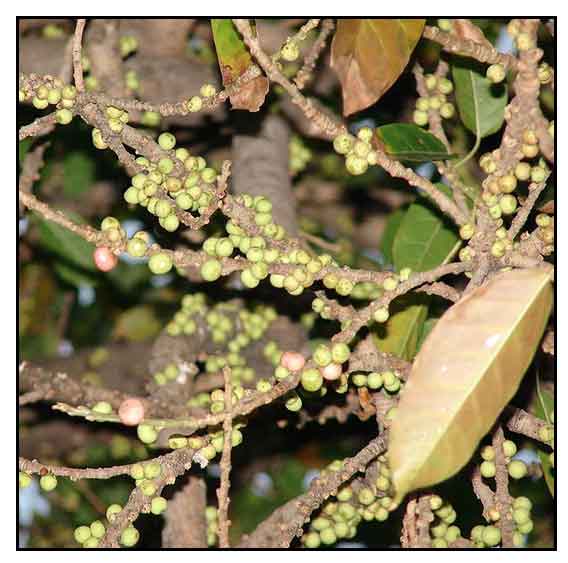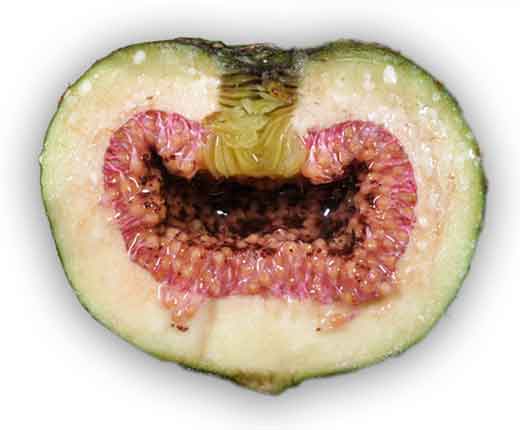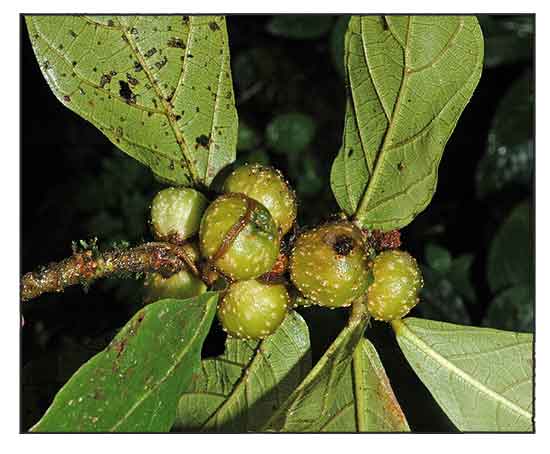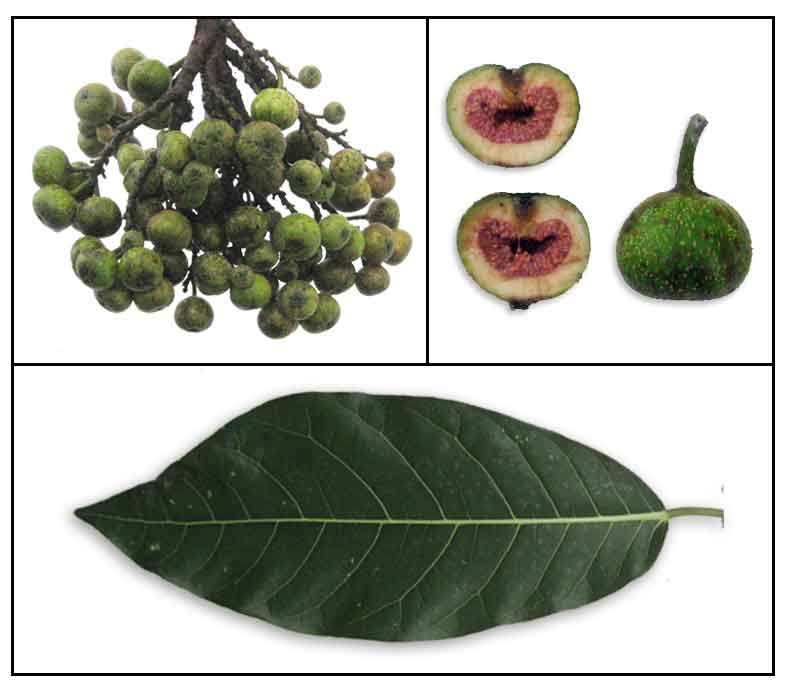 Gen info Gen info
- Ficus nota is a species of flowering plant in the family Moraceae.
- It is primarily dispersed by birds that eat the fruits and excrete the seeds.
Botany
Tibig is an erect, spreading, dioecious perennial tree, growing to a height
of 8-10 meters. Branchlets are hairy. Leaves oblong to elliptic-obovate, 15 to 35 centimeters long and 8 to 12 centimeters wide; soft and pubescent beneath, the margins irregular and distinctly toothed, the apex abruptly acute, and the base auriculate. Midrib of leaves is stout, with 7 to 9 pairs of ascending, curved nerves. Petiole is brown, tomentose, 3 to 5 centimeters long. Tubercles are mostly cauline, occasionally from larger branches, clustered, rebranched, rigid, 20 centimeters long, bracteate. Figs are subglobose, 2 to 3.5 centimeters in diameter, glabrous, fleshy, pedunculate, green, becoming yellowish-white at the base, the umbilical scales exerted. Peduncle is acute, 2 centimeters long, with three bracts.
Distribution
- Native to the Philippines.
-
In thickets and forests, especially in areas saturated with water, at low and medium altitudes.
- Used as live fence.
- Occurs in Batan Island, Polilio, Mindoro, Culion and Balabac regions of Palawan, Panay, Samar, Leyte.
- Also occurs in North Borneo.
Constituents
- Dichlormethane extract of unripe fruits yielded 4-(2-hydroxyethyl)- 2-methoxyphenol (1), a mixture of meso-2,3-butanediol (2a), (2R,3R)-2,3-butanediol (2b) and (2S,3S)-2,3- butanediol (2c) and β-sitosterol (3). (2)
- Phytochemical screening of ethanolic extract of fruit and leaves yielded alkaloids, tannins, flavonoids, saponins, and anthraquinones. (see study below) (6)
 - Ethanolic leaf extract yielded alkaloids, flavonoids, phenols, terpenoids, saponins, and tannins. Total phenolic and flavonoid content were 348.3 ± 3.2 mg GAE/g and 2.64 ± 0.06 mg QE/g, respectively. (see study below) (9) - Ethanolic leaf extract yielded alkaloids, flavonoids, phenols, terpenoids, saponins, and tannins. Total phenolic and flavonoid content were 348.3 ± 3.2 mg GAE/g and 2.64 ± 0.06 mg QE/g, respectively. (see study below) (9)
- Study of leaves isolated six diarylbutanoids, ficusnotins A-F. (10)
- In a study of leaf extracts for total phenolic content (TPC) and total flavonoid content (TFC), highest concentration was 145.65 mg/g Gallic Acid Equivalent (GAE) from ethyl acetate extract and 279.68 mg/g Quercetin Equivalent (QE) from chloroform extract. (see study below) (11)
- Ethanol crude extract of leaves yielded carbohydrates, flavonoids, saponins, tannins, and glycosides. (see study below) (12)
- Study isolated two new C11-terpenes with an octahydrobenzofuran skeleton, ficusnotadiol (1) and ficusnotanone (2). (see study below) (16)
- Histochemical testing of Ficus nota fruits revealed alkaloids +++, formic acid +++, glycosides +++, saponins +, tannins ++.
(17)
- Ficusnotins are natural biarylbutanoids isolated from leaves of Ficus nota. Study reports on the concise synthesis of ficusnotin E via ruthenium-catalyzed conjugate addition of 3,4-dimethoxyphenylboronic acid to a benzylvinyl ketone. (19)
Properties
- Studies have suggested antioxidant, cytotoxicity, antibacterial, skin whitening, xanthine oxidase inhibitory properties.
Parts
used
Bark, fruit, leaves
and seeds.
 Uses Uses
Edibility
- Ripe fruits are edible but rather tasteless; usually eaten with sugar.
- Young leaves eaten as vegetable.
Folkloric
- Water extracted from standing tree drunk three times daily for fever.
- Extracted water applied to relieve muscle pain.
- Decoction of roots and bark used for urinary tract inflections, hypertension, and diabetes.
- Water from cut branches used for urinary infections.
- The Mansaka tribe of the Compostela Valley used a bark decoction to treat asthma, cough, and other respiratory conditions. (4)
- The Ayta people of Porac, Pampanga use the stem of the plant species as repellent against hematophagous insects. (4) Used for toothache and stomachache. (5) Ayta communities in Dinalupiha, Bataan, apply leaves to the forehead for headache or fever, and apply heated leaves to the stomach for stomach aches. (20)
- In Aklan, the Ati tribe drink a decoction of root for postpartum care and recovery and as milk production enhancer. (14)
- Stem decoction also used as galactagogue.
- In Agusan del Norte, Philippines, decoction of leaves, fruit, and stem drunk for treat urinary tract infections.
- Indigenous Ati Negrito women use the milky white latex in the stems and other organs as galactagogue. Stem decoction used orally as milk production enhancer. (21)
Other
- Wood: Used as firewood or charcoal.
- Repellent: Stems burned as insect repellent.
- Mummification: In the Cordillera, Ficus nota is one of the plants used as antibacterial in the preservation process of fire mummies. (13)
- Agroforestry: Planted along creeks to control erosion.
Studies
• Constituents: Dichlormethane extract of unripe fruits yielded 4-(2-hydroxyethyl)- 2-methoxyphenol (1), a mixture of meso-2,3-butanediol (2a), (2R,3R)-2,3-butanediol (2b) and (2S,3S)-2,3- butanediol (2c) and β-sitosterol (3). (2)
• Cytotoxicity / Stems: Study evaluated the potential cytotoxicity of stems of Ficus nota in brine shrimp lethality assay. Water and absolute ethanol extracts of stems showed activity against the brine shrimp with LC50 of 991.00 ppm and 852.22 ppm, respectively. (4)
• Antibacterial / Fruit and Leaves: Study evaluated the antibacterial activities of ethanolic extract of Ficus nota fruit and leaves against pathogenic pathogens viz. Escherichia coli, Staphylococcus aureus, Klebsiella pneumonia, and Salmonella typhimurium. Results showed significant antibacterial activity when compared to standard Chloramphenicol. Cytotoxicity results showed higher toxicity with fruit compared with leaf extract. (see constituents above) (6)
• Antioxidant / Leaves: In a study of Philippine medicinal plants for antioxidant activity, a leaf decoction of Ficus nota showed 88.19% at 500 ppm against DPPH, 216.64 mg GAE, 55.52 AAE, and 77.05 BHTE. Results suggest potential of F. nota as an important source of natural antioxidants. (7)
• Antimicrobial / Cytotoxicity / Leaves: Study evaluated the antimicrobial and cytotoxic potential of various extracts of Ficus nota leaves. An aqueous extract showed active to very active levels of inhibition against three bacteria viz., B. subtilis, S. aureus and E. coli and activity against two fungi, S. cerevisiae and C. albicans. All plant extracts displayed toxicity (LC50 <1000 g/ml) against brine shrimp lethality assay, with the crude ethanol and chloroform extracts showing LC50 values of less than 250 g/ml. (8)
• Total Phenolic and Flavonoid Contents / Free Radical Scavenging Activity / Leaves: Study of ethanol leaf extract showed concentration dependent inhibitory effect on DPPH, ABTS, ad NO radical with EC50 of 970.6, 269.8 and >5000 ppm, respectively. It also showed high dose dependent reducing capacity (EC50=548.3 ppm) and metal chelating potential (EC50=27.53 ppm) towards iron. Results suggest a dual potential in biological and pharmaceutical applications beneficial for treatment and prevention of various diseases i.e., diabetes, cardiovascular, cancer, and aging. (see constituents above) (9)
• Xanthine Oxidase Inhibitory / Leaves and Fruits: Study evaluated the potential xanthine oxidase inhibitory activity of Ficus nota methanolic leaf extracts. In vitro assay tested the XO inhibitory activity of three pooled fractions and showed IC50s of 341.3, 328.4, and 334.5 µg/mL,respectively, and allopurinol with IC50 of 195.6 µg/mL. Results showed comparable XO inhibitory activity to standard drug Allopurinol. (see constituents above) (11)
• Antidiabetic / Alpha-Glucosidase Inhibitory Activity / Leaves: In a study of selected Ficus species for in vitro mammalian alpha-glucosidase inhibitory activity, the ethanol crude extract of Ficus nota leaves showed most significant inhibitory activity against mammalian alpha-glucosidase activity with lowest IC50 of 8.666 µg/mL. (see constituents above) (12)
• Antibacterial / Cytotoxicity / Antioxidant / Leaves: A crude chloroformic fraction from ethanolic extract of leaves of F. nota exhibited activity against Bacillus subtilis and Staphylococcus aureus and cytotoxicity against Artemia salina. A leaf decoction showed considerable antioxidant and free-radical scavenging activity against DPPH. (see constituents above) (16)
• Antibacterial / Cytotoxicity / Antioxidant / Leaves: Study evaluated the antibacterial activities of Tubog (Ficus nota) ethanolic extract of fruit and leaves against E. coli ATTC 25922, S. aureus ATTC 25923, K. pneumonia UPCC 1360, and S. typhimurium UPCC 1368. Qualitative screening revealed presence of common bioactive compounds including alkaloids, tannins, flavonoids, saponins, steroids, and anthraquinones in both fruits and leaves. The aqueous extract showed significantly good antibacterial activity compared to standard Chloramphenicol. Cytotoxicity results were higher with the fruit compared to the leaves. (17)
• Whitening Ingredient / Invention: Invention relates to a whitening composition containing Ficus nota extract as an active ingredient, more specifically, Pikus note extracted with water, alcohol, or a mixture thereof as a solvent in a melanin-producing cell line. With its antioxidant activity and little cytotoxicity, it suggests potential as a melanin reducing and skin whitening cosmetic product. (18)
Availability
Wild-crafted.
|


![]()

